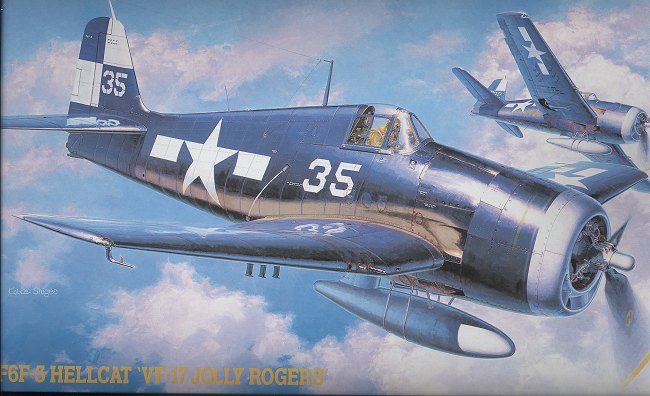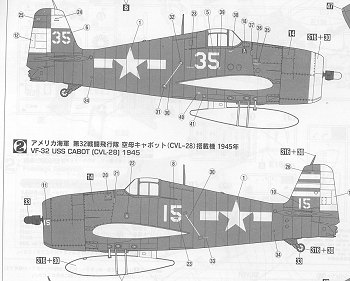
|
KIT: |
Hasegawa 1/48 F6F-5 Hellcat |
|
KIT # |
JT 35 |
|
PRICE: |
$31.98 |
|
DECALS: |
2 aircraft: VF-17 and VF-32 circa 1945 |
|
REVIEW & |
|
|
NOTES: |
|

|
HISTORY |
Just to put it all in a nutshell, the F6f was undoubtedly the finest all-round American Naval fighter of WW2. Though not as fast as the Corsair, it was ideal for its role at sea. It was fast enough to defeat it's enemies, heavily armed with 6 .50 cal machine guns, easy to fly, easy to land and it was a tough aircraft that could take a lot of damage.
Designed in late 1941, some of the design was influenced by the A6Ms that were captured during the early months of the war, especially its excellent maneuverability. The Navy was so confident in the design that it was ordered into production before the prototype flew. The aircraft achieved the best kill ratio of any Naval fighter before or since at 19:1. Once the war was over, unlike the Corsair, the Hellcat was quickly removed from the inventory and scrapped in huge numbers. Today there are a few in museums and a few are still flying as warbirds.
|
THE KIT |
Dated 1996, this is one of Hasegawa's more recent vintage kits. Detailing is everything one would expect from a modern kit. Excellent engraved detailing, a complete cockpit with all the appropriate knobs and switches and a two piece canopy. If this is like the F6F-3, and it is, it will be difficult to display the cockpit open as the canopy is too thick to fit on the fuselage spine. Items that are with this kit that are not with the similar F6F-3 are rockets and the wing stubs for them. Should you wish, an F6F-3 can be made from all the parts in the kit, though you would be on your own for decals.
 There are markings
for two aircraft, both of them in overall sea blue. One is from VF-17 aboard the
USS Hornet. It has a white cowling with the white checked tail and wing tip that
was part of the instant recognition marks so prominent in late 1944 and early
1945. The other is from VF-32 on the USS Cabot with a white rudder and three
stripes on the tail. All this is on the decal sheet, but white is notoriously
difficult to scan so here are the schemes from the instruction sheet.
There are markings
for two aircraft, both of them in overall sea blue. One is from VF-17 aboard the
USS Hornet. It has a white cowling with the white checked tail and wing tip that
was part of the instant recognition marks so prominent in late 1944 and early
1945. The other is from VF-32 on the USS Cabot with a white rudder and three
stripes on the tail. All this is on the decal sheet, but white is notoriously
difficult to scan so here are the schemes from the instruction sheet.
Speaking of which, the sheet is typical in that it gives an excellent and unambiguous depiction of the construction sequences, including color callouts. These colors are from the Gunze Sangyo range that we are all, by now, familiar.
Finally, I should mention, that this kit really is an F6F-3 as it sits in the box. To do a -5 one needs to fill in and rescribe a few panel lines as well as remove a few lumps.
Having built the -3 version a few years ago, I can tell you that this will be a very smooth build and leave you with an excellent example of one of the best from the Grumman 'Iron Works'.
Review kit courtesy of me and my wallet!
If you would like your product reviewed fairly and quickly by a site that has over 800 visits a day, please contact me or see other details in the Note to Contributors.